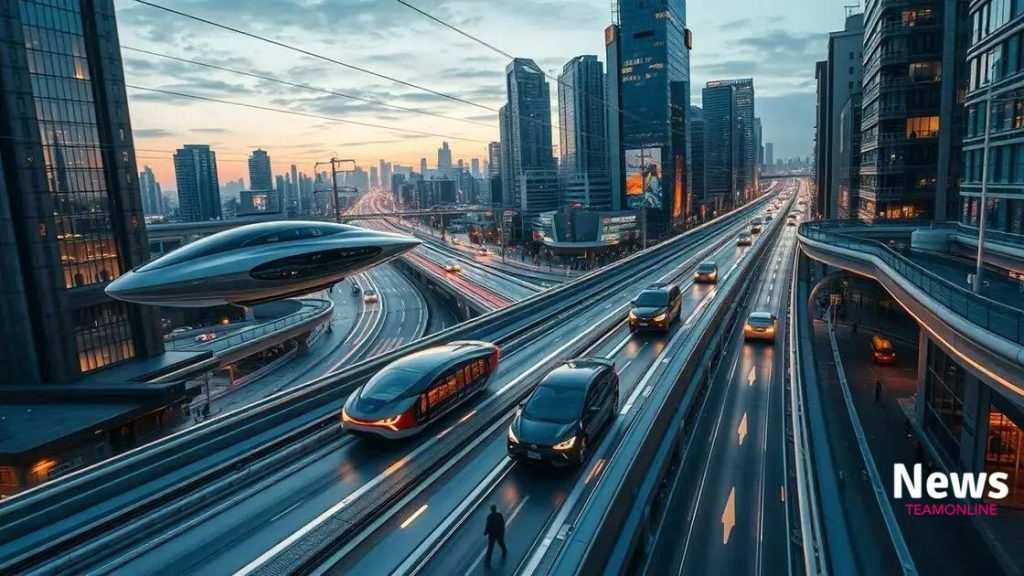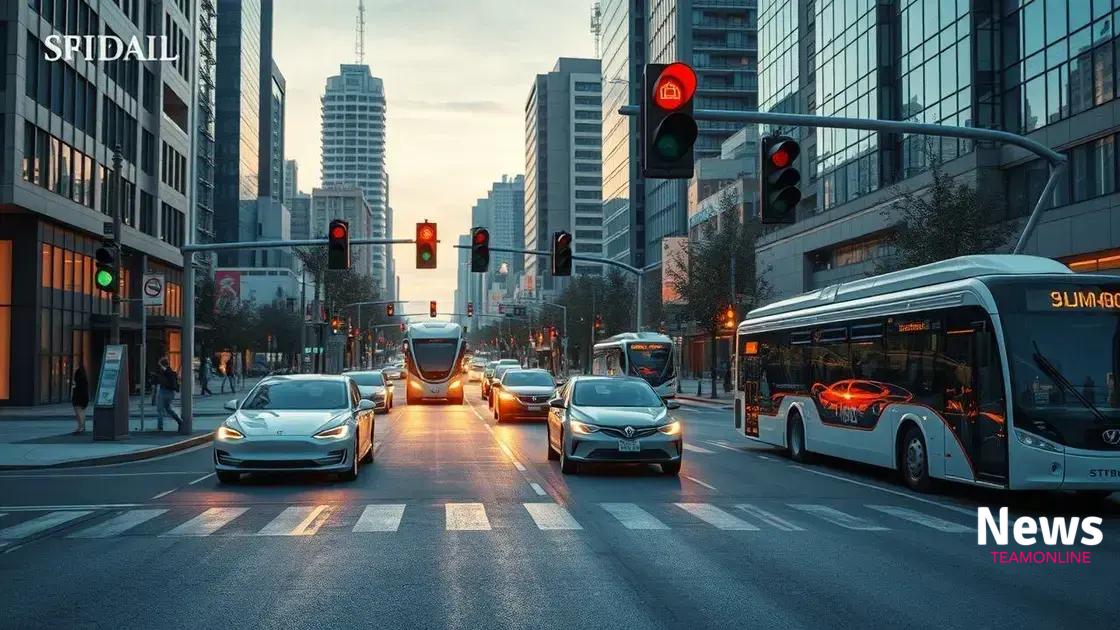Transport modernization proposals: the future of mobility

Transport modernization proposals include adopting electric and autonomous vehicles, smart mobility solutions, and infrastructure enhancements, creating efficient, safe, and sustainable transportation systems in urban environments.
Transport modernization proposals are reshaping how we navigate our world. Have you ever thought about how these advancements could impact your daily commute? Let’s dive into the exciting changes ahead.
Understanding transport modernization
Understanding transport modernization is crucial in today’s fast-paced world. Transport modernization refers to the adoption of advanced technologies and practices to improve transportation systems.
Key Aspects of Transport Modernization
This modernization can take many forms, influencing everything from urban planning to personal commutes. As cities grow, improving transportation becomes essential for keeping up with the needs of residents.
- Improved efficiency through smart systems
- Enhanced passenger experience with real-time updates
- Reduced environmental impact using alternative fuels
By embracing modern technologies, cities can create systems that are more reliable and efficient. For instance, automated traffic signals can manage traffic flow better, reducing congestion and improving safety.
Benefits of Understanding Transport Modernization
One key benefit of understanding these proposals is the ability to adapt to future challenges. Knowing how to implement these changes means we can address issues like climate change, population growth, and urban sprawl effectively.
- Promotes sustainable practices in urban settings
- Increases accessibility for all residents
- Encourages economic growth through efficient transport systems
As cities move towards innovative solutions, citizens can enjoy more choices in their travel options. Understanding how transport modernization operates enables communities to advocate for effective changes.
Key benefits of modernizing transport systems
Modernizing transport systems brings numerous advantages that enhance daily life and support urban development. By updating these systems, communities can address various challenges effectively.
Efficiency in Travel
One of the primary benefits of modernized transport systems is increased efficiency. With the integration of smart technologies, travel times can be reduced significantly. For example, real-time tracking allows passengers to plan their journeys better. This leads to less waiting and more reliable services.
- Reduced congestion through smarter traffic management
- Shorter travel times on public transport
- Better connectivity between different transport modes
Moreover, streamlined processes help in lowering the overall costs for both commuters and service providers. This economic benefit supports sustainable development in urban areas.
Environmental Impact
Modernized transport systems also focus on environmental sustainability. By using clean energy technologies, emissions can be significantly decreased. Electric buses and trains are great examples of this shift.
- Lower greenhouse gas emissions
- Improved air quality in urban areas
- Promotion of green spaces and sustainable practices
This shift not only combats climate change but also promotes healthier communities. Communities can enjoy greener environments while benefiting from improved transport systems.
Finally, modernizing transport systems encourages innovation in urban planning. As cities evolve, these systems must adapt to meet the needs of a growing population, ensuring accessibility for all residents. This creates a more equitable transportation landscape, providing choices that cater to diverse needs.
Innovative technologies in transportation

Innovative technologies in transportation are revolutionizing how we move. These advancements make travel faster, safer, and more efficient. Today, we see technologies that not only enhance our daily commutes but also promote sustainability.
Smart Traffic Management
One major innovation is smart traffic management systems. These use data and technology to optimize traffic flow, reducing congestion. By employing sensors and cameras, cities can monitor real-time conditions.
- Improved traffic light synchronization
- Detection of accidents or delays
- Real-time traffic updates for motorists
Such systems help reduce travel times and improve the overall commuting experience. This technology allows cities to adapt quickly to changing conditions, enhancing the journey for all road users.
Electric and Autonomous Vehicles
Electric and autonomous vehicles represent another significant leap. Electric vehicles (EVs) reduce reliance on fossil fuels, helping to combat pollution and greenhouse gas emissions. Meanwhile, autonomous vehicles promise to change how we think about mobility.
- Enhanced safety features through automation
- Reduction of traffic accidents
- Increased accessibility for all users
By providing safer and cleaner options, these technologies can transform urban transportation. Their potential to reshape entire cities is truly remarkable, creating environments that place people first.
Moreover, integrating these technologies into public transportation systems can further enhance their effectiveness. For instance, electric buses or smart train systems are becoming increasingly popular. They create an interconnected network that provides reliable travel options, encouraging more people to use public transport.
Case studies of successful transport modernization
Case studies of successful transport modernization showcase how cities around the world are adapting to new technologies and practices. These examples serve as valuable lessons for other urban areas looking to improve their transport systems.
Barcelona’s Smart Mobility Initiatives
One prominent case is Barcelona, which has implemented smart mobility initiatives to reduce traffic congestion and promote cycling. The city introduced a bike-sharing program that encourages residents to choose bicycles over cars.
- Reduction in traffic congestion
- Enhanced urban air quality
- Increased public transport usage
These efforts have resulted in Barcelona becoming one of the leading cities in sustainable transport, proving that modernizing transport can also foster community well-being.
Singapore’s Integrated Transport System
Another excellent example is Singapore, which has an integrated transport system. This system combines public transport, cycling paths, and walking routes, making it easy for people to get around.
- Seamless connection between bus, train, and bike systems
- Real-time information for commuters
- Incentives for using public transport
By prioritizing accessibility and efficiency, Singapore has created a model that other cities might emulate. The result is a comprehensive framework that enhances the commuter experience.
These case studies highlight the effectiveness of combining technology with community-focused transport solutions. By observing successful implementations, other cities can adopt similar strategies tailored to their unique needs, making transport modernization a global movement.
Future trends in transport advancements
Future trends in transport advancements are shaping how we will move in the coming years. As technology rapidly evolves, it directly influences transportation methods and systems across the globe.
Rise of Electric Vehicles
One major trend is the rise of electric vehicles (EVs). With cities pushing for cleaner air and reduced emissions, EVs are becoming more popular.
- Decreased dependency on fossil fuels
- Advancements in battery technology
- Government incentives for EV adoption
This shift will lead to more charging stations and infrastructure for electric cars, creating a more sustainable future in urban transport.
Smart Mobility Solutions
Additionally, smart mobility solutions are gaining traction. This involves using technology to improve the efficiency of transport systems. For example, apps that provide real-time data on public transport help commuters plan their journeys better.
- Increased convenience for users
- Better route planning using AI
- Integration of multiple transport modes
These advancements will lead to smarter cities, where transportation systems adapt to the needs of the population.
Moreover, autonomous vehicles are expected to revolutionize road travel. These self-driving cars promise safer roads and reduced traffic accidents. With companies testing these technologies, we may witness widespread adoption sooner than expected.
Lastly, the focus on reducing environmental impact will continue to shape future trends. More cities are likely to adopt sustainable transport solutions, emphasizing public transportation, biking, and walking over car dependency. This shift will play a vital role in combating climate change and urban congestion.
FAQ – Frequently Asked Questions about Transport Modernization
What are the key benefits of modernizing transport systems?
Modernizing transport systems improves efficiency, reduces emissions, and enhances public safety. It also promotes sustainable practices and better connectivity.
How will electric vehicles impact urban transportation?
Electric vehicles will reduce air pollution and dependence on fossil fuels, making urban environments cleaner and more sustainable.
What role do smart technologies play in transport modernization?
Smart technologies help optimize traffic management, provide real-time data for commuters, and integrate multiple modes of transportation for better efficiency.
Can you give examples of cities successfully modernizing their transport systems?
Cities like Barcelona and Singapore have successfully modernized their transport systems by implementing bike-sharing programs, smart mobility solutions, and integrated public transport networks.





